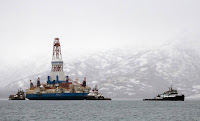There is no legal precedent for Trump to undo Obama's order of permanent protection from drilling, and action by Congress would take years.
President Donald Trump issued an executive order on Friday aimed at resurrecting offshore drilling in the Arctic—an area that Barack Obama had protected in one of his final moves as president.
It comes during a flurry of executive orders issued this week as Trump nears his 100th day in office, and is among several administration actions designed to unleash unfettered fossil fuel production on public lands and waterways. But when it comes to drilling in the Arctic, it's not clear just how much Trump can legally accomplish, and any attempt to overturn existing protections will likely face a protracted legal battle from environmental advocates.
When Obama ordered the permanent protection of nearly 120 million acres of Arctic and Atlantic waters from drilling just a month before he left office, many wondered just how "permanent" that would be.
The area in question includes the entirety of the Chukchi Sea and most of the Beaufort Sea off Alaska, as well as a stretch of the Atlantic Ocean from Massachusetts to Virginia. Obama's executive order relied on his powers under the Outer Continental Shelf Lands Act of 1953 (OCSLA), which allows a president to withdraw certain areas from drilling.
Trump's order, called the America-First Offshore Energy Strategy, directs Interior Secretary Ryan Zinke to lift the ban in some of the areas Obama had sought to protect. It also directs Zinke to review the current five-year plan, which dictates which federal waters can be leased and does not include the banned areas.
The executive order also instructs regulators to reexamine their policy on seismic testing in areas where it is currently not allowed, and it instructs Commerce Secretary Wilbur Ross to review marine monuments and sanctuaries created or expanded in the past 10 years, while refraining from designating any news ones.
...
Legally, Trump may be on shaky ground when it comes to overturning Obama's withdrawal, though. The legal underpinning of Obama's move—OCSLA—states that "The President of the United States may, from time to time, withdraw from disposition any of the unleased lands of the outer Continental Shelf."
So Obama clearly had the authority to issue the ban, said David Uhlmann, the director of the Environmental Law and Policy Program at the University of Michigan Law School. "The more difficult question is whether a subsequent president can alter that withdrawal, or whether it is truly permanent," he said.
Those defending the ban will likely argue that because the act does not explicitly say that subsequent presidents can undo a withdrawal, it should stand.
"No prior presidents have ever purported to undo a permanent withdrawal once it's been put in place," said Erik Grafe, an attorney with Earthjustice. "It'd be an unprecedented action and, we think, unlawful."
Read more at Trump Moves to Lift Arctic Offshore Drilling Ban, but It Might Not Be So Easy

No comments:
Post a Comment